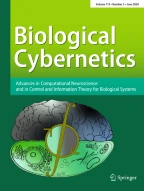Abstract
A computer model of sustained chopper neurons in the ventral cochlear nucleus is presented and investigated. In the companion paper, the underlying neurophysiological and neuroanatomical data are demonstrated. To explain the preference of chopper neurons for oscillations with periods which are multiples of a 0.4 ms synaptic delay, we suggest a model of circularly connected chopper neurons. In order to simulate chopper neurons within a physiological dynamic range for periodicity encoding, it is necessary to assume that they receive an input from onset neurons. Our computer analysis of the resulting simple neuronal network shows that it can produce stable oscillations. The chopping can be triggered by an amplitude-modulated signal (AM). The dynamic range and the synchronous response of the simulated chopper neurons to AM are enhanced significantly by an additional input from onset neurons. Physiological properties of chopper neurons in the cat, such as mean, standard deviation, and coefficient of variation of the interspike interval are matched precisely by our simulations.
Similar content being viewed by others
Abbreviations
- CN:
-
Cochlear nucleus
- AVCN:
-
Anterior ventral cochlear nucleus
- PVCN:
-
Posterior ventral cochlear nucleus
- DCN:
-
Dorsal cochlear nucleus
- IC:
-
Inferior colliculus
- AN(F):
-
Auditory nerve (fibre)
- AM:
-
Amplitude-modulated signal
- SAM:
-
Sinusoidal amplitude-modulated sine wave
- CF:
-
Characteristic frequency
- CV:
-
Coefficient of variation
- SPL:
-
Sound pressure level
- PSTH:
-
Poststimulus time histogram
- PSP:
-
Postsynaptic potential
- PSC:
-
Postsynaptic current
- EPSP:
-
Excitatory postsynaptic potentials
- AP:
-
Action potential
- ISI:
-
Interspike interval
- VS:
-
Vector strength
References
Arle JC, Kim DO (1991) Neural modeling of intrinsic and spike-discharge properties of cochlear nucleus neurons. Biol Cybern 64:273–283
Banks MI, Sachs M (1991) Regularity analysis in a compartment model of chopper units in the anteroventral cochlear nucleus. J Neurophysiol 65:606–629
Batra R, Kuwada S, Standford TR (1989) Temporal coding of envelopes and their interaural delays in the inferior colliculus of the unanesthetized rabbit. J Neurophysiol 61:257–268
Beutner D, Voets T, Neher E, Moser T (2001) Calcium dependence of exocytosis and endocytosis at the cochlear inner hair cell afferent synapse. Neuron 29:681–690
Blackburn C, Sachs M (1989) Classification of unit types in the anteroventral cochlear nucleus: PST histograms and regularity analysis. J Neurophysiol 62:1303–1329
Bleeck S (2000) Holistische Signalverarbeitung in einem Modell latenzverknüpfter Neuronen. PhD thesis, TU Darmstadt
Bourk TR (1976) Electrical responses of neuronal units in the anteroventral cochlear nucleus of the cat. PhD thesis, MIT
Carney LH (1993) A model for the responses of low-frequency auditory-nerve fibers in cat. J Acoust Soc Am 93:401–417
Caspary DM, Backoff PM, Finlayson PG, Palombi PS (1994) Inhibitory inputs modulate discharge rate within frequency receptive fields of anteroventral cochlear nucleus neurons. J~Neurophysiol 72:2124–2133
Ferragamo M, Golding N, Oertel D (1998) Synaptic inputs to stellate cells in the ventral chochlear nucleus. J Neurophysiol 79:51–63
Frisina RD, Smith RL, Chamberlain SC (1985) Differential encoding of rapid changes in sound amplitude by second order auditory neurons. Exp Brain Res 60:417–422
Frisina RD, Smith RL, Chamberlain SC (1990a) Encoding of amplitude modulation in the gerbil cochlear nucleus: I. A hierarchy of enhancement. Hear Res 44:99–122
Frisina RD, Smith RL, Chamberlain SC (1990b) Encoding of amplitude modulation in the gerbil cochlear nucleus: II. Possible neural mechanisms. Hear Res 44:123–142
Golding NL, Ferragamo M, Oertel D (1999) Role of intrinsic conductances underlying responses to transients in octopus cells of the cochlear nucleus. J Neurosci 19:2897–2905
Greenwood DD (1990) A cochlear frequency-position function for several species—29 years later. J Acoust Soc Am 87:2592–2605
Heil P, Schulze H, Langner G (1995) Ontogenetic development of periodicity coding in the inferior colliculus of the mongolian gerbil. Audit Neurosci 1:363–383
Hewitt MJ, Meddis R, Shakleton TM (1992) A computer model of a cochlear-nucleus stellate cell: responses to amplitude-modulated and pure-tone stimuli. J Acoust Soc Am 91:2096–2109
Langner G (1981) Neuronal mechanisms for pitch analysis in the time domain. Exp Brain Res 44:450–454
Langner G (1983) Evidence for neuronal periodicity detection in the auditory system of the guinea fowl: implications for pitch analysis in the time domain. Exp Brain Res 52:333–355
Langner G (1992) Periodicity coding in the auditory system. Hear Res 60:115–142
Langner G, Schreiner C (1988) Periodicity coding in the inferior colliculus of the cat: I. Neuronal mechanisms. J Neurophysiol 60:1799–1822
Moser T, Beutner D (2000) Kinectics of exocytosis and endocytosis at the cochlear inner hair cell afferent synapse of the mouse. PNAS 97:11883–11888
Mountain DC, Cody AR (1999) Multiple modes of inner hair cell stimulation. Hear Res 132:1–14
Müller-Preuss P, Flachskamm C, Bieser A (1994) Neural encoding of amplitude modulation within the auditory midbrain of squirrel monkeys. Hear Res 80:197–208
Oertel D, Bal R, Gardner SM, Smith PH, Joris PX (2000) Detection of synchrony in the activity of auditory nerve fibers by octopus cells of the mammalian cochlear nucleus. PNAS 97:11773–11779
Palmer A, Jiang D, Marshall DH (1996) Responses of ventral cochlear nucleus onset and chopper units as a function of signal bandwidth. J Neurophysiol 75:780–794
Rall W (1967) Distinguishing theoretical synaptic potentials computed for different somadendritic distributions of synaptic inputs. J Neurophysiol 30:1138–1168
Rees A, Langner G (2005)Temporal coding in the auditory midbrain. In: The inferior colliculus, Springer, Berlin Heidelberg New york, pp 346–376
Rothman J, Manis P (2003) The roles potassium currents play in regulating the electrical activity of ventral cochlear nucleus neurons. J Neurophysiol 89:3097–3113
Strube HW (1985) A computationally efficient basilar-membrane model. Acustica 58:207–214
Wiegrebe L, Meddis R (2004) The representation of periodic sounds in simulated sustained chopper units of the ventral cochlear nucleus. J Acoust Soc Am 115:1207–1218
Zwicker E (1986) A hardware cochlear nonlinear preprocessing model with active feedback. J Acoust Soc Am 80:146–153
Author information
Authors and Affiliations
Corresponding author
Rights and permissions
About this article
Cite this article
Bahmer, A., Langner, G. Oscillating neurons in the cochlear nucleus: II. Simulation results. Biol Cybern 95, 381–392 (2006). https://doi.org/10.1007/s00422-006-0091-7
Received:
Accepted:
Published:
Issue Date:
DOI: https://doi.org/10.1007/s00422-006-0091-7
